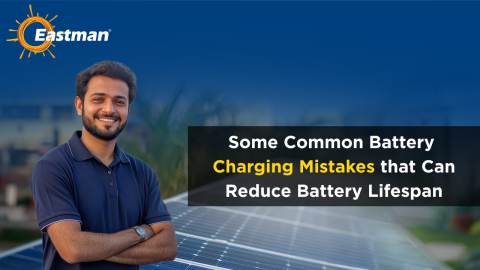
Essential Tips to ensure proper working of inverter battery
In the heart of our digitally-driven world, where the hum of electricity powers our homes, offices, and the devices that connect us, lies a crucial and often overlooked component: the inverter. As our lives become increasingly interlaced with technology, understanding the role of this unassuming electronic device becomes essential.
In its elegant simplicity, an inverter battery backup holds the power to transform our understanding of energy conversion. It enables us to seamlessly switch between different currents and keep our modern lives humming. Even when external forces threaten to disrupt our daily routines.
This article dives into the world of inverter with battery for home and unravels its mechanisms. We will explore their significance and shed light on their crucial contributions to maintaining the rhythm of our technologically-fuelled existence.
What is an Inverter Battery?
Our appliances run on AC power. The inverter stores DC current, converts it to AC current, and supplies the converted power to the appliances. The battery is needed optimize the supply of electric charge needed for the inverter to function as intended.
Here are 3 reasons why the lead acid inverter battery is crucial -
1 - Power Backup
Lead-acid batteries serve as a reliable backup power source during electrical outages. They ensure that essential appliances and devices continue to operate. This way the battery offers comfort and convenience during power outages.
2 - Energy Storage in Renewable Systems
In renewable energy systems, such as solar and wind installations, lead-acid batteries store excess energy generated during sunny or windy periods. This comes in handy for use during periods of low energy production. This enhances energy self-sufficiency and reduces reliance on the grid.
3 - Uninterrupted Power Supply (UPS)
Lead-acid batteries are commonly used in uninterruptible power supply (UPS) systems for computers, servers, and critical equipment. They provide immediate power backup when the primary power source fails. This prevents data loss and downtime.
Tips to ensure proper working of inverter battery backup
1- Choose the Right Battery Type
Selecting the appropriate battery type is the first step toward ensuring the optimal performance of your inverter system. The most common types of batteries used in inverters are lead-acid batteries. It can include tubular and maintenance-free variants. Each type has its advantages and disadvantages in terms of lifespan and efficiency. And even maintenance requirements. Research and consult experts to determine the best battery type for your needs and budget.
2- Invest in Standard products
When it comes to inverter with battery for home, caliber matters. Investing in a reputable and reliable brand might initially seem costlier, but it pays off in the long run. High-quality batteries are designed to endure frequent charging and discharging cycles. They offer better efficiency and have longer lifespans. They are also less prone to leakage and other common issues.
3- Check Acid Levels
Monitoring the acid levels is crucial for batteries that require maintenance, like lead-acid batteries. It can significantly impact a battery’s performance and longevity. Low acid levels can expose the lead plates, leading to sulfation and reduced capacity. To maintain optimal levels, periodically check and adjust the levels using distilled water. However, avoid overfilling, as excess water can dilute the acid concentration. Follow the manufacturer’s guidelines for the recommended acid level range and frequency of checks. Avoid using tap water or mineral water, as impurities can affect battery performance.
4- Proper Placement
Correct installation and placing it right play a crucial role in the performance of your inverter battery. Install the battery in a cool and well-ventilated area to prevent overheating. Adequate ventilation prevents the buildup of gases produced during charging. It ensures safety and prolongs battery life. Additionally, make sure the battery is securely placed on a stable surface to prevent accidents and damage.
5- Regular Inspection
Examining the battery timely and maintenance is key to ensuring the proper working of your inverter battery. Check for physical damage or corrosion on terminals. You need to ensure there are no loose connections and signs of leakage. Clean the battery terminals periodically using a water and baking soda concoction to prevent corrosion. Tighten any loose connections and ensure that cables are properly secured.
6- Keep Battery Charged
Frequent charging and discharging cycles are inevitable for inverter batteries. To maintain optimal performance, ensure that the battery remains charged. Avoid deep discharges, as they can significantly reduce battery life. Recharge the battery as soon as it reaches around 50% capacity. Modern inverters often have indicators or alarms to alert you when the battery is running low.
7- Regular Testing
Conduct timely trials and calibration to monitor the health of your inverter battery. Many inverters come with built-in battery testing features. These tests assess the battery’s state of charge and overall condition. The regular examination helps you identify potential issues before they escalate. It ensures the battery’s longevity and consistent performance.
8- Scheduled Maintenance
While homeowners can perform some upkeep tasks, it’s advisable to have a professional technician inspect and service your inverter battery periodically. Experts can conduct thorough checks and clean components effectively. They can identify potential problems that might not be visible to the untrained eye. Routine professional maintenance can extend the life of your battery and prevent unexpected breakdowns.
9- Avoid Overloading
Overloading your inverter can strain the battery and significantly reduce its lifespan. Make sure to calculate your power needs accurately before connecting devices to the inverter. Consult the manufacturer’s guidelines or seek expert advice to determine the appropriate load capacity for your inverter system.
10- Use The Compatible Charging Equipment
You need to ensure that you have compatible charging equipment, most preferably of the same brand. It is essential to prevent overcharging or undercharging your inverter battery. Overcharging can lead to excessive heating and electrolyte loss. On the other hand, undercharging can result in sulfation. It is a condition that reduces battery performance. Follow the manufacturer’s recommendations for charging equipment and ensure that it matches the battery’s specifications.
11- Check for Damaged Wires
Cables and connections play a pivotal role in the proper functioning of your inverter battery system. Over time, they can become frayed or corroded. Wires can be damaged due to environmental conditions or wear and tear. Damaged cables can hinder the flow of electricity. It can cause inefficiency and potentially compromise the battery’s lifespan. Regularly inspect the wires and connections for any signs of wear or corrosion. Replace or repair damaged wires promptly to ensure consistent and efficient power flow.
12- Do Not Mix Battery Types
Combining several types of batteries in the same battery bank is not recommended. Each type has distinct charging and discharging properties; merging them can result in inconsistent performance and decreased battery life.
13- Expose to Extreme Temperatures
Extremely high or low temperatures are brutal on inverter batteries. Avoid placing the battery in very cold or hot conditions since this can cause it to degrade faster and perform worse.
14- Ignore Battery Alarms
Pay attention to any battery alerts or signs your inverter may have. Ignoring low battery alerts can result in deep discharges that harm the battery’s health.
To sign off
When you connect a battery to an inverter it helps distribute the stored power to the appliances in case of power supply failure. Batteries also help the inverter to store the power when the power supply resumes. Their importance in maintaining a continuous power supply cannot be understated.
They also contribute to a cleaner environment through sustainable energy use. As technology continues to change our lives, the role of backup power supply for home remains steadfast. It reflects their essence as enablers of convenience and efficiency.
Recent Blogs

How Eastman Solar Battery Backup is Suitable for Residential & Commercial
With rising electricity demands, frequent grid fluctuations, and the growing shift toward renewable energy, solar battery backup
Read More
Why BMS is Critical for Solar Lithium Batteries
As solar energy adoption accelerates across residential, commercial, and industrial sectors, lithium batteries have quickly becom
Read More
How Solar Batteries Work at Night: The Complete Process
Ever wondered what happens to your solar power after sunset? Your panels are asleep, the sky is dark, yet your home still runs smoothly: fans spinning
Read More
Some Common Battery Charging Mistakes that can Reduce Battery Lifespan
In today’s power-driven world, whether you rely on solar batteries, inverter batteries, lead-acid batteries, or lithium-ion batteries, maximizing
Read More
Why Eastman Solar Combo Kits Are the Perfect All-in-One Solution
In an era where sustainable living is not just a choice but a necessity, embracing solar energy stands out as a powerful step forward.
Read More
